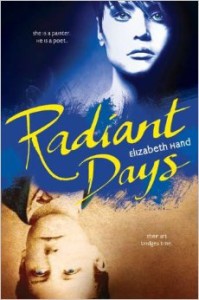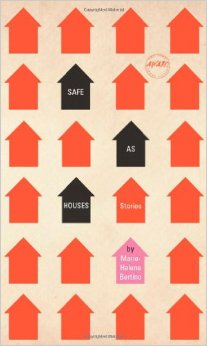I’m going to share my thoughts about some of the books I’ve read recently, though I should be preparing the syllabus for my summer class that starts next week. I hope you will forgive me for at lest one of these things. These reviews are for novels, novellas, and short-story collections that particularly struck me in my sabbatical reading, and so I highly recommend all of them (the order below is pretty random). Perhaps in another post I’ll share some of my recommendations from the tons of graphic novels I’ve also been reading, if anyone’s interested. Given my devotion to the miniature, be not surprised at the lengths of these reviews.
 The Memory Garden (2014) and Holiday (2010) by Mary Rickert. I’d read some of Rickert’s short stories prior to reading her first novel and her second short-story collection (the first collection, Map of Dreams, I bought after reading The Memory Garden, but I haven’t read it yet), so I was eager to read more of her work. The Memory Garden is a beautiful novel: the story of teenage Bay and her much-older adopted mother Nan reunited with her childhood friends after decades one summer weekend. Rickert’s prose is a joy to read, and I liked the rather contained plot, even if I’d figured out the secret long before the end (and I’m a sucker for witch stories, even if it’s just suggested). And it’s Rickert’s prose again in the stories that comprise Holiday that kept me wanting more.
The Memory Garden (2014) and Holiday (2010) by Mary Rickert. I’d read some of Rickert’s short stories prior to reading her first novel and her second short-story collection (the first collection, Map of Dreams, I bought after reading The Memory Garden, but I haven’t read it yet), so I was eager to read more of her work. The Memory Garden is a beautiful novel: the story of teenage Bay and her much-older adopted mother Nan reunited with her childhood friends after decades one summer weekend. Rickert’s prose is a joy to read, and I liked the rather contained plot, even if I’d figured out the secret long before the end (and I’m a sucker for witch stories, even if it’s just suggested). And it’s Rickert’s prose again in the stories that comprise Holiday that kept me wanting more.
 Glimmerglass: A Novel (2014) by Marly Youmans. I was familiar with Youmans as a poet, but I didn’t know she also wrote novels (silly me, I thought Glimmerglass was her first novel, but not so). Youmans’ writing is breathtaking throughout this short novel. Here’s a passage from the first chapter:
Glimmerglass: A Novel (2014) by Marly Youmans. I was familiar with Youmans as a poet, but I didn’t know she also wrote novels (silly me, I thought Glimmerglass was her first novel, but not so). Youmans’ writing is breathtaking throughout this short novel. Here’s a passage from the first chapter:
She leaned her forehead against the leaded glass and looked out at the hollyhocks—their seeds buttoned up for winter, with only a few flowers like pink crepe paper left on the stalks—and at Michaelmas daisies and misguided spring bulbs with shoots pushing up crumbs of earth. She was glad to see their bravery, and there was something consoling about the perfect shapes, motionless in the cold air.
The novel’s protagonist is Cynthia Sorrell, a middle-aged artist, two characteristics rarely scene in fantasy novels (and what intrigued me about the novel), who moves into an odd little house in the little village of Cooper Patent, where she meets odd but endearing people and then finds herself caught up in a decades-old mystery. The second half of the novel felt a bit rushed to me, but, oh, that writing!
 By Nightfall (2010) by Michael Cunningham. I’ve been a devoted reader of Cunningham’s for many years now, and I’ve read all of his books except for The Snow Queen, which I’ll read soon (well, I’ve never read Golden States, his first novel, because he’s basically disavowed it, and I’m a loyalist). Coming as no surprise: I love his prose (a theme develops, dear reader). Here’s the official description for By Nightfall:
By Nightfall (2010) by Michael Cunningham. I’ve been a devoted reader of Cunningham’s for many years now, and I’ve read all of his books except for The Snow Queen, which I’ll read soon (well, I’ve never read Golden States, his first novel, because he’s basically disavowed it, and I’m a loyalist). Coming as no surprise: I love his prose (a theme develops, dear reader). Here’s the official description for By Nightfall:
Peter and Rebecca Harris: mid-forties denizens of Manhattan’s SoHo, nearing the apogee of committed careers in the arts—he a dealer, she an editor. With a spacious loft, a college-age daughter in Boston, and lively friends, they are admirable, enviable contemporary urbanites with every reason, it seems, to be happy. Then Rebecca’s much younger look-alike brother, Ethan (known in the family as Mizzy, “the mistake”), shows up for a visit. A beautiful, beguiling twenty-three-year-old with a history of drug problems, Mizzy is wayward, at loose ends, looking for direction. And in his presence, Peter finds himself questioning his artists, their work, his career—the entire world he has so carefully constructed.
The plot here is sparse, but Cunningham really delves into Peter’s character in a way I found fascinating. And I was convinced I had figured out very early on a twist in the story—that Mizzy is actually Rebecca’s son—but there was no twist, no such twist at all! But, despite that crushing blow to my sense of my own cleverness, I still really enjoyed the novel. Plus, how could I not love a novel that uses this Rilke quotation as its epigraph: “Beauty is nothing but the beginning of terror”?
 The Life-Changing Magic of Tidying Up: The Japanese Art of Decluttering and Organizing (2014) by Marie Kondo. Some might not find this book of particular interest, but I’m afraid I’m going to have to praise it for the huge change it’s made in my life—and I didn’t even follow the program all the way through. In the book, Kondo describes her KonMari Method of decluttering via a category-by-category system, so effective that none of her clients re-lapse into clutter and her waiting list is three months long. The basic method is that you gather together everything in a particular category (clothes, books, etc.) and you hold each item in your hand and ask yourself, “Does this bring me joy?” If so, you keep it; if not, you give it away or discard. Sure, the method sounds a little odd, but it works—I’ve managed to get rid of a lot of stuff that no longer brings me joy and might never have, in fact, and I didn’t even go full KonMari!
The Life-Changing Magic of Tidying Up: The Japanese Art of Decluttering and Organizing (2014) by Marie Kondo. Some might not find this book of particular interest, but I’m afraid I’m going to have to praise it for the huge change it’s made in my life—and I didn’t even follow the program all the way through. In the book, Kondo describes her KonMari Method of decluttering via a category-by-category system, so effective that none of her clients re-lapse into clutter and her waiting list is three months long. The basic method is that you gather together everything in a particular category (clothes, books, etc.) and you hold each item in your hand and ask yourself, “Does this bring me joy?” If so, you keep it; if not, you give it away or discard. Sure, the method sounds a little odd, but it works—I’ve managed to get rid of a lot of stuff that no longer brings me joy and might never have, in fact, and I didn’t even go full KonMari!
 Trigger Warning: Short Fictions & Disturbances (2015) by Neil Gaiman. I read most of these stories before, and the ones I hadn’t read I enjoyed. But I can’t say this is among my favorite of Gaiman’s collections, which would be Angels and Visitations, Fragile Things, and Smoke and Mirrors. Maybe part of it was reading his introduction first, wherein I felt he was trying too hard to justify his use of the title. My favorite piece, though, was the American Gods novella at the end, “Black Dog”—a wondrous thing indeed.
Trigger Warning: Short Fictions & Disturbances (2015) by Neil Gaiman. I read most of these stories before, and the ones I hadn’t read I enjoyed. But I can’t say this is among my favorite of Gaiman’s collections, which would be Angels and Visitations, Fragile Things, and Smoke and Mirrors. Maybe part of it was reading his introduction first, wherein I felt he was trying too hard to justify his use of the title. My favorite piece, though, was the American Gods novella at the end, “Black Dog”—a wondrous thing indeed.
 Get In Trouble: Stories (2015) by Kelly Link. I’m not even sure what more I can say except if you’re not reading Kelly Link you’ve left an enormous jagged hole in your soul. She creates these perfect, immersive fictional worlds in the space of a few pages, and she does it so expertly and finely that I still, after almost fifteen years of reading her work, can’t quite figure out how she does it. I have taught her first collection, Stranger Things Happen, several times, and some of my all-time favorite stories are in that collection (“The Specialist’s Hat,” “Travels with the Snow Queen,” “The Girl Detective,” etc.). This new collection contains fewer stories, but each one will lift off the top of your skull.
Get In Trouble: Stories (2015) by Kelly Link. I’m not even sure what more I can say except if you’re not reading Kelly Link you’ve left an enormous jagged hole in your soul. She creates these perfect, immersive fictional worlds in the space of a few pages, and she does it so expertly and finely that I still, after almost fifteen years of reading her work, can’t quite figure out how she does it. I have taught her first collection, Stranger Things Happen, several times, and some of my all-time favorite stories are in that collection (“The Specialist’s Hat,” “Travels with the Snow Queen,” “The Girl Detective,” etc.). This new collection contains fewer stories, but each one will lift off the top of your skull.
 Wilde Stories 2014: The Year’s Best Gay Speculative Fiction, edited by Steve Berman. An excellent anthology of gay speculative fiction, and the 2014 edition has been one of the best so far (plus, look at that fantastic—in all senses of the word—cover art by Marianna Stelmach!). I can honestly say there wasn’t a story in here that I didn’t enjoy, but I did enjoy some more than others. My favorite five, listed in order of their appearance in the anthology: “Caress” by Eli Easton, “57 Reasons for the Slate Quarry Suicides” by Sam J. Miller, “The Water that Falls on You from Nowhere” by John Chu, “Super Bass” by Kai Ashante Wilson, and “Midnight at the Feet of the Caryatides” by Cory Skerry. I’m really looking forward to the 2015 edition (and I’ll admit it, I’m swooning over that cover, too)!
Wilde Stories 2014: The Year’s Best Gay Speculative Fiction, edited by Steve Berman. An excellent anthology of gay speculative fiction, and the 2014 edition has been one of the best so far (plus, look at that fantastic—in all senses of the word—cover art by Marianna Stelmach!). I can honestly say there wasn’t a story in here that I didn’t enjoy, but I did enjoy some more than others. My favorite five, listed in order of their appearance in the anthology: “Caress” by Eli Easton, “57 Reasons for the Slate Quarry Suicides” by Sam J. Miller, “The Water that Falls on You from Nowhere” by John Chu, “Super Bass” by Kai Ashante Wilson, and “Midnight at the Feet of the Caryatides” by Cory Skerry. I’m really looking forward to the 2015 edition (and I’ll admit it, I’m swooning over that cover, too)!
 Radiant Days (2012) by Elizabeth Hand.Here’s the cover copy to describe this novel:
Radiant Days (2012) by Elizabeth Hand.Here’s the cover copy to describe this novel:
She is a painter. He is a poet. Their art bridges time.
It is 1978. Merle is in her first year at the Corcoran School of Art, catapulted from her impoverished Appalachian upbringing into a sophisticated, dissipated art scene. It is also 1870. The teenage poet Arthur Rimbaud is on the verge of breaking through to the images and voice that will make his name. The meshed power of words and art thins the boundaries between the present and the past—and allows these two troubled, brilliant artists to enter each other’s worlds.
I am a huge fan of Hand’s work, so much so that I was kind of a stammering, awkward, shy idiot when I met her at one of my MFA residencies (the only other writer to whom I’ve had that kind of reaction when I met her was Kelly Link). As you might have guessed, I love Hand’s prose, and I’m always comforted as a writer by her rather loose plots coupled with wonderful characterization and focus on artists (especially painters). I’m very excited about Hand’s new novella, Wylding Hall, which is available now on Audible (a full-cast recording!) and will be published in hardcover and limited edition by PS Publishing in July (do you even need to ask if I pre-ordered a copy of the signed, slipcased limited edition the moment I heard about it? no, you do not).
 There Once Lived a Woman Who Tried to Kill Her Neighbor’s Baby: Scary Fairy Tales (2009) by Ludmilla Petrushevskaya, translated by Keith Gessen and Anna Summers. I have a fondness for Russian fantasists and surrealists, like Gogol and Bulgakov, so I was delighted to learn about Petrushevskaya. To be honest, I was sold on the title alone, even before I found out she was Russian. Take note of the title of her other short-story collection translated into English—There Once Lived a Girl Who Seduced Her Sister’s Husband, and He Hanged Himself: Love Stories—and her collection of novellas—There Once Lived a Mother Who Loved Her Children, Until They Moved Back In: Three Novellas about Family. The stories in There Once Lived a Woman… feel very Russian to me with their dark humor and acceptance of the mysterious. I’m not sure if I’d classify Petrushevskaya’s work as magical realism or surrealism, but I definitely want to read more of her work.
There Once Lived a Woman Who Tried to Kill Her Neighbor’s Baby: Scary Fairy Tales (2009) by Ludmilla Petrushevskaya, translated by Keith Gessen and Anna Summers. I have a fondness for Russian fantasists and surrealists, like Gogol and Bulgakov, so I was delighted to learn about Petrushevskaya. To be honest, I was sold on the title alone, even before I found out she was Russian. Take note of the title of her other short-story collection translated into English—There Once Lived a Girl Who Seduced Her Sister’s Husband, and He Hanged Himself: Love Stories—and her collection of novellas—There Once Lived a Mother Who Loved Her Children, Until They Moved Back In: Three Novellas about Family. The stories in There Once Lived a Woman… feel very Russian to me with their dark humor and acceptance of the mysterious. I’m not sure if I’d classify Petrushevskaya’s work as magical realism or surrealism, but I definitely want to read more of her work.
 The Night Circus (2011) by Erin Morgenstern. When this novel first came out, I knew I wanted to read it, but, alas, I’d already succumbed to my dread of long novels. So I didn’t read it, but I started following Morgenstern’s blog and tumblr, fell in love with her flax-golden tales (every week for five years, Morgenstern wrote a 10-sentence story based on a photograph by Carey Farrell). When I was on sabbatical, I was determined to read this novel, and believe me I’m so happy I did. I loved this novel and the Victorian London Morgenstern created with magicians and a marvelous circus—and, of course, her delicious writing. The characters were well drawn, and the plot well executed (I loved the shifts in time until the future storyline and the “present” storyline collided). Nothing felt off to me about this novel, and that’s saying something.
The Night Circus (2011) by Erin Morgenstern. When this novel first came out, I knew I wanted to read it, but, alas, I’d already succumbed to my dread of long novels. So I didn’t read it, but I started following Morgenstern’s blog and tumblr, fell in love with her flax-golden tales (every week for five years, Morgenstern wrote a 10-sentence story based on a photograph by Carey Farrell). When I was on sabbatical, I was determined to read this novel, and believe me I’m so happy I did. I loved this novel and the Victorian London Morgenstern created with magicians and a marvelous circus—and, of course, her delicious writing. The characters were well drawn, and the plot well executed (I loved the shifts in time until the future storyline and the “present” storyline collided). Nothing felt off to me about this novel, and that’s saying something.
 Safe as Houses: Stories (2012) by Marie-Helene Bertino. I finished this collection last night, and Bertino’s writing really blew me away. Her writing is spare but so incredibly evocative, each story like a poem (you may be able to tell from my comments above that style is terribly important to me as a reader). In an Irish Times article last week, Isabelle Cartwright compares crosswords and poetry thus:
Safe as Houses: Stories (2012) by Marie-Helene Bertino. I finished this collection last night, and Bertino’s writing really blew me away. Her writing is spare but so incredibly evocative, each story like a poem (you may be able to tell from my comments above that style is terribly important to me as a reader). In an Irish Times article last week, Isabelle Cartwright compares crosswords and poetry thus:
“There is a kind of pure logic to both the well-composed poem and the well-composed crossword. There can only be one outcome: if the poem is cohesive and follows a coherent progression of images, then the concluding lines are somehow inevitable, although still surprising. It is the same with the well-made clue: it can lead to only one word, and that’s always the answer.” (Thanks to The Rooster Moans Poetry Cooperative for posting the link on Facebook.)
Bertino’s story have this same inevitability for me, especially “Great, Wondrous,” the unfolding of which just about blew my socks off and by the end I was in tears, though I don’t know if the story would feel particularly sad to others. “Carry Me Home, Sisters of Saint Joseph” also wrung an emotional reaction from me, but several of the stories are hilarious and all carry this undercurrent (or over-current) of the surreal.






